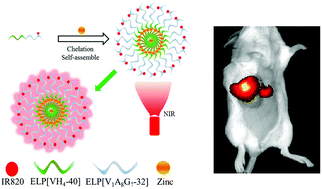IR820 covalently linked with self-assembled polypeptide for photothermal therapy applications in cancer†
Abstract
Owing to the unique advantages of high specificity and minimal invasiveness, photothermal therapy (PTT) has been evidenced with great potential in cancer treatment. However, most photothermal agents present a shortage of photobleaching and nonspecific biodistribution in clinical application. In this study, we conjugated a new Indocyanine Green Dye (IR820) with self-assembled polypeptide (ELP) via chemical bonding in an aqueous environment. This preparation method could effectively avoid damaging the polypeptide. ELP-IR820 was fabricated as nanoconjugates with diameters of approximately 50 nm. The use of ELP-IR820 notably enhanced photothermal-mediated cytotoxicity on CT-26 cancer cells. We demonstrate that the ELP-IR820 nanoparticles significantly improved drug accumulation in the tumor and photothermal effect in vivo compared to the free dye and monomer ELP-IR820. ELP-IR820 nanoparticle also exhibited outstanding ability to cause prominent tumor tissue growth inhibition via the photothermal effect. No noticeable toxicity was detected for all treatment groups. These investigations broaden the application of NIR dyes as a multimodal photothermal therapy platform.



 Please wait while we load your content...
Please wait while we load your content...